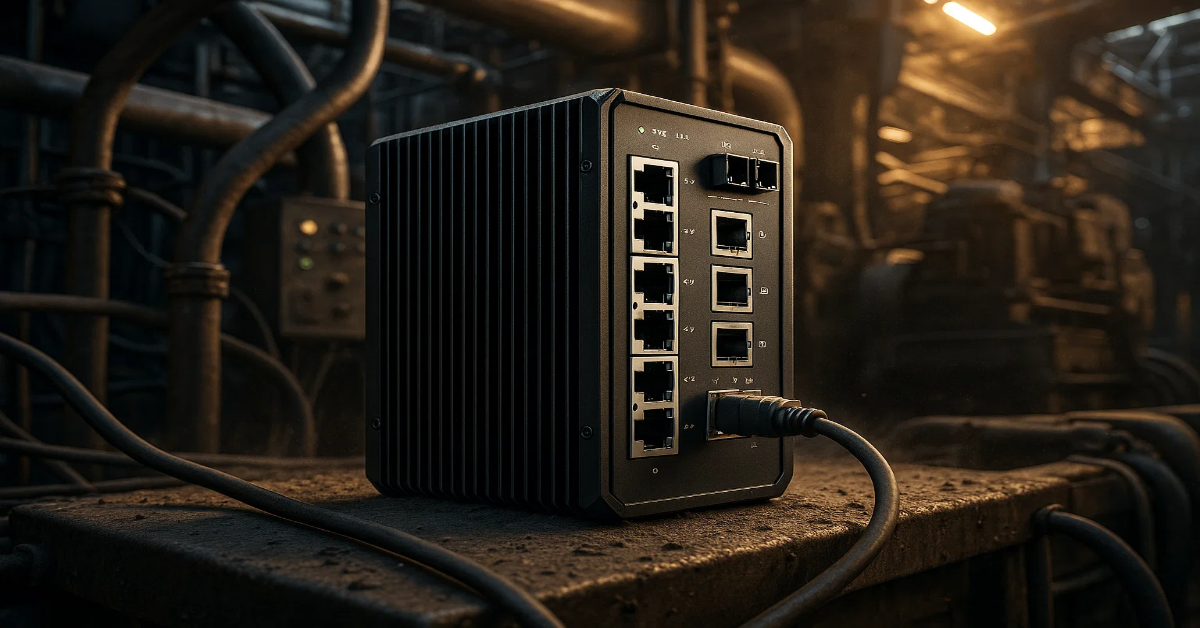In today’s industrial environments, the demand for reliable and high-performance networking solutions is greater than ever. Factories, energy plants, transportation systems and large-scale manufacturing facilities rely heavily on seamless data communication to ensure smooth operations.
This is where industrial-grade network switches come into play. Unlike standard commercial switches, industrial-grade switches are designed to withstand harsh conditions, provide exceptional uptime and ensure critical network reliability.

In this article, we will explore the important factors that make a network switch “industrial grade,” its benefits and why businesses increasingly prefer them for mission-critical operations.
1. Understanding Network Switches
A network switch is a hardware device that connects multiple devices within a local area network (LAN), such as computers, servers and sensors. It manages data traffic by receiving, processing and forwarding data packets to the appropriate devices.
While commercial-grade switches are suitable for offices and data centres, industrial environments demand a different standard of robustness. Here’s why.
2. Durability and Environmental Tolerance
Industrial-grade switches are built to survive extreme conditions that would typically damage regular switches. Key features include:
-
Wide Operating Temperature Range: Industrial switches can operate in temperatures from -40°C to +75°C, compared to the 0°C–40°C range of commercial switches. This is crucial for outdoor or factory-floor installations.
-
Resistance to Dust and Moisture: Many industrial switches are rated with IP30 to IP67, protecting them from dust, water and other contaminants.
-
Shock and Vibration Tolerance: These switches are engineered to withstand vibrations from heavy machinery and sudden impacts, ensuring uninterrupted network performance.
This robustness ensures that the network remains operational even under the harshest industrial conditions.
3. Redundancy and Reliability
Industrial-grade switches are designed for mission-critical applications, where network downtime can result in costly production losses. Some key reliability features include:
-
Redundant Power Supplies: If one power source fails, a backup ensures the switch continues operating.
-
Ring Network Topologies: Many industrial switches support protocols like RSTP (Rapid Spanning Tree Protocol) or proprietary ring protocols to quickly reroute traffic if a connection fails.
-
Fail-Safe Mechanisms: Automatic detection and recovery from network failures minimise downtime.
These features collectively enhance network resilience and reliability in demanding industrial scenarios.
4. Advanced Network Management
Industrial-grade switches provide enhanced network management capabilities, giving IT teams better control over traffic and security. Features often include:
-
VLAN Support: Separates network traffic for different departments or production lines to improve efficiency.
-
QoS (Quality of Service): Prioritises critical data, such as real-time control signals or surveillance video, over less critical traffic.
-
SNMP Monitoring: Enables proactive monitoring, alerts and diagnostics, helping engineers prevent potential network issues.
These management tools are essential for maintaining optimal network performance in complex industrial setups.
5. Enhanced Security Features
Industrial networks are increasingly targeted by cyber threats. Industrial-grade switches offer advanced security to protect sensitive operations:
-
Port Security: Restricts unauthorised devices from connecting to the network.
-
Access Control Lists (ACLs): Filters and blocks suspicious traffic.
-
Encrypted Communication: Supports secure protocols to prevent data interception.
Implementing these features ensures that critical industrial processes remain protected from cyber risks.
6. Scalability and Flexibility
Industrial operations often grow over time, requiring networks that can scale without compromising performance. Industrial-grade switches are built to:
-
Support High Port Density: Accommodate multiple devices in large industrial plants.
-
Offer Modular Options: Allow addition of extra ports or modules as network needs expand.
-
Integrate with Legacy Systems: Many industrial switches support older protocols alongside modern Ethernet standards.
Scalability ensures long-term network sustainability and cost-effectiveness.
7. Low Latency and High Performance
Industrial processes, particularly in automation and control, rely on real-time data. Industrial-grade switches are optimised for:
-
Low Latency: Ensures rapid data transmission between machines, sensors and control systems.
-
High Throughput: Handles large volumes of data without congestion or delays.
-
Deterministic Communication: Supports protocols like PROFINET, Modbus TCP and EtherNet/IP for predictable and precise data delivery.
These features are critical in sectors like manufacturing, transportation, and energy, where even milliseconds of delay can impact productivity.
8. Compliance with Industrial Standards
Industrial-grade switches must comply with rigorous industry standards to guarantee reliability:
-
IEC 61850: For utility automation networks.
-
IEEE 802.3: For Ethernet connectivity.
-
NEMA or IP Ratings: Ensure protection against environmental hazards.
Compliance assures users that the switches can operate safely in specialised industrial conditions.
9. Longevity and Total Cost of Ownership
While industrial-grade switches may cost more upfront than commercial ones, their long-term reliability reduces maintenance costs and operational risks. Features contributing to longevity include:
-
Rugged construction with metal housings
-
Extended warranty and support services
-
Energy-efficient designs to reduce power consumption
By minimising network downtime and maintenance frequency, these switches offer better total cost of ownership over time.
10. Real-World Applications
Industrial-grade switches are widely used across sectors that demand resilient and high-performance networks, including:
-
Manufacturing Plants: For automation and real-time monitoring of machinery.
-
Transportation Systems: Supporting intelligent traffic systems and railway signalling.
-
Energy Sector: Power plants, solar farms, and wind turbines rely on industrial switches for continuous monitoring and control.
-
Oil & Gas: Network switches in refineries and offshore rigs withstand extreme heat, vibration and moisture.
These applications highlight why investing in industrial-grade switches is not just a preference; it’s a necessity.
In industrial settings, network reliability is not optional; it’s a critical factor for productivity, safety and operational efficiency. Industrial-grade network switches distinguish themselves through rugged design, advanced management features, high performance and adherence to strict industrial standards.
Whether it’s managing automated production lines, monitoring critical infrastructure, or ensuring seamless data flow in harsh environments, industrial-grade switches are the backbone of reliable industrial networking.
For businesses aiming to build a resilient and future-proof network, understanding what makes a switch “industrial grade” is the first step toward intelligent infrastructure planning.
